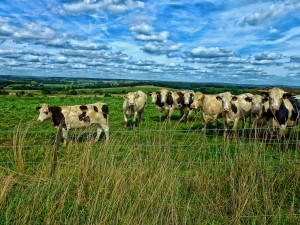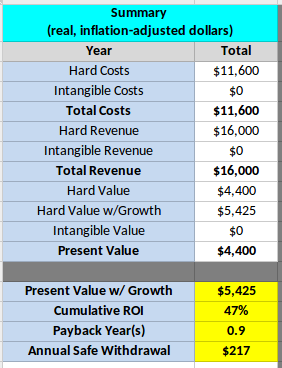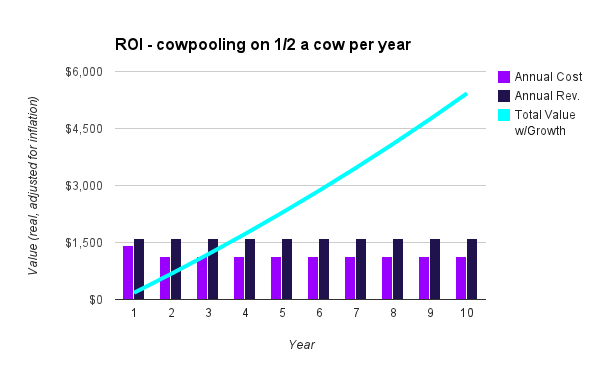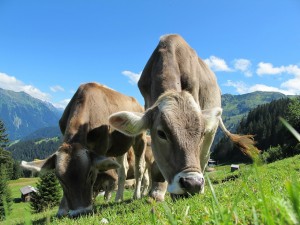Abstract
Cowpooling, the process of pooling money with other individuals to buy portions of a cow for meat, can save people a lot of money or cost them a lot of money. For the household that already buys a lot of beef at a natural/ethical market like Whole Foods, there is the potential to save around $5,400 every 10 years.
However, for the household that buys a lot of conventional beef at a normal supermarket, cowpooling is a more dubious proposition and could, worst-case scenario, end up costing the cowpooler more than $4,500 over a decade.
Intro

What is cowpooling? Much like it sounds, cowpooling is when a group of people pools their money together to buy a cow for meat. Why would people buy cows instead of just getting beef at the grocery store? There are a few reasons:
- Likely healthier (grass-fed, fewer antibiotics)
- More humane (pasture-raised vs. factory farmed)
- Cheaper (sometimes)
- More convenient (fewer trips to the grocery)
- Local
I’m sure there are other reasons, but those are the ones with the strongest draw for me, roughly in order of importance.
A standard cow costs about $2,000 to $2,500, which isn’t prohibitively expensive but definitely isn’t cheap either. I think most people that cowpool could probably afford to buy a whole cow, but the two limiting factors are shelf life and storage space.
Frozen beef stays good for about a year, maybe more, but a year is generally the safe rule of thumb (with vacuum packing). The other limiting factor is storage space. Most residential freezer/fridge combos can’t hold 400 pounds of beef, the typical yield from a full cow.
For these reasons, we have cowpoolers that opt to buy 1/8, 1/4, and 1/2 cows at a time instead. This allows them to eat it before it gets freezer burn and to fit all the meat into a freezer in the first place.
The Numbers
For this example, I’m going to assume that people purchase half a cow, or 200 pounds of meat per year at a cost of $1,100 ($5.50 per lb). This is about 1/2 a pound per day for one person or 1/4 per day for two people. I’m also assuming that a new $300 freezer will be required to store the meat and that this freezer will cost $30 in electricity each year.
I need to compare the cowpooling example to something, so my alternative scenario is buying grass-fed beef at whole foods, from a csa, or at farmers markets. I’m assuming 100 pounds of ground beef at a cost of $6.00 per pound and 100 pounds of steaks, roasts, and stew meat at an average of $10.00 per pound.
Running these scenarios through the ROI model yields the following:
- 10-Year NPV: $5,425
- 10-Year ROI: 47%
- 10-Year Payback: 0.9 years


Not too shabby… $5,400 per decade compared to whole foods or farmer’s market equivalent cuts.
But the reality of the situation might be more complicated. What if someone doesn’t buy grass-fed beef normally? Grass-fed beef is much more expensive. If we’re comparing buying 1/2 a cow to buying just traditional factory farm, grain-fed beef, then there aren’t any savings; you’d actually lose about $80 a year going the cowpool route (based on $4.00 per pound ground beef and $7.00 per pound other cuts in super market).
Moreover, what if someone not only didn’t buy grass-fed beef, but they also didn’t buy anything except for the cheapest cuts, ground beef, and manager’s specials. Assuming this person would spend merely $4.00 per pound on all 200 pounds of beef per year, cowpooling would actually cost $450 more every year versus the super market… over $4,500 every 10 years.
Commentary
To sum things up, depending on what your current beef buying habits are now, cowpooling could be a really smart financial decision, a somewhat neutral financial decision, or a really bad one. The thing about it for me, however, is that finances aren’t the most important aspect of the decision. They are a factor, to be sure, but not at the top of my list.

I’d like to be the kind of person that “votes” with my dollar in all aspects of life (renewable energy, animal welfare, corporate responsibility, etc.), but sometimes it is damn expensive! Is it worth $450 per year to get healthy, happy, pasture-raised, grass-fed, grass-finished beef instead of the pink slime sold the grocery store? That’s a tough one that I’ll have to dwell on more.
The general principle here applies to a lot of different meats, however. I’ve run the numbers for what kind of grocery bill savings you would need each year to break even on the freezer + electricity, and the answer is about $66 in savings every year (less than $6 per month). So if you can figure out how to shave $66 bucks off your grocery store bill, while being healthier, more ethical, etc. by buying other kinds of protein & meat in bulk (turkey, chicken, rabbits, pork, lamb, goat, game, etc.), go for it.
If not, and you do decide to go with the beef option, you’ll be happy to know that defrosting isn’t necessary for a succulent steak. In fact, steaks cooked straight from the freezer actually taste better according to the guys at America’s Test Kitchen (things just got a little more convenient for the hot-shot cowpoolers out there).
So that’s that. Cowpooling is a complicated decision that probably makes the most sense for the especially health-conscious and ethical beef-eaters out there, the ones that are already most likely to buy from a CSA, Whole Foods, or farmer’s markets.
*All this being said, I am aware that beef is arguably one of the most carbon-intensive protein sources around.